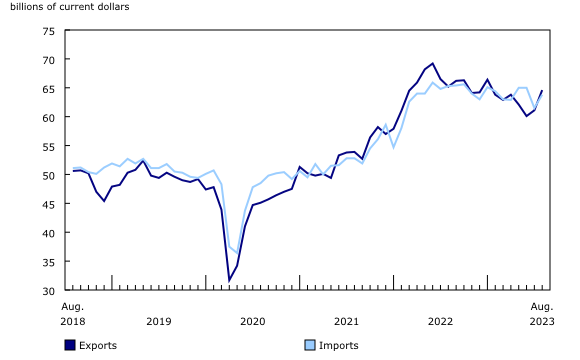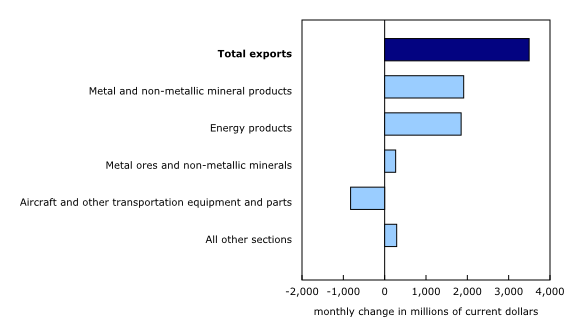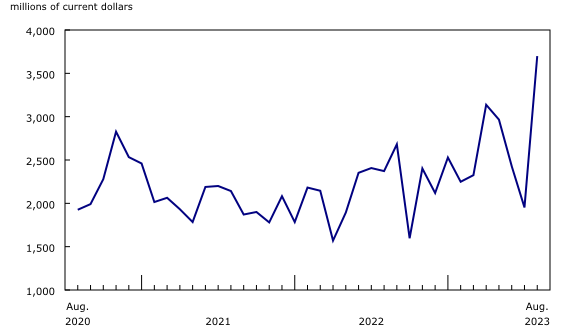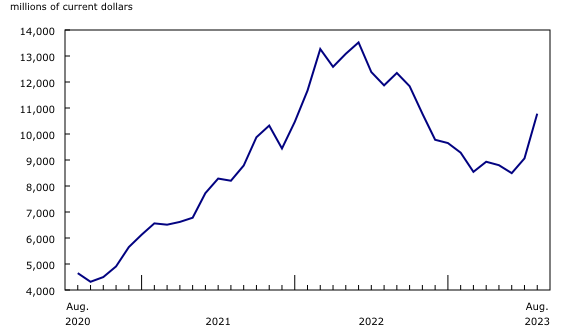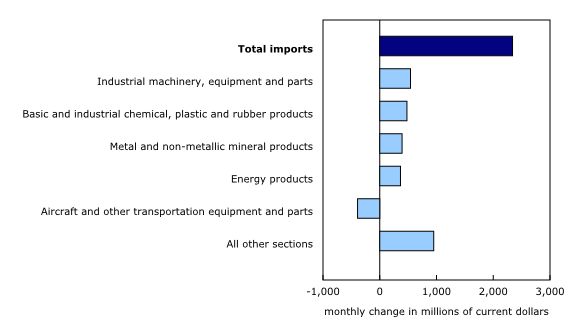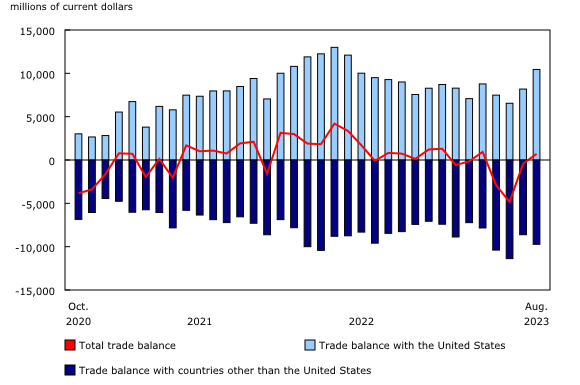Canadian international merchandise trade, August 2023
Released: 2023-10-05
In August, Canada's merchandise exports increased 5.7%, while imports rose 3.8%. These strong monthly gains followed disruptions in port operations in British Columbia, which affected merchandise trade activity in July.
Canada's merchandise trade balance went from a deficit of $437 million in July to a surplus of $718 million in August, the first trade surplus observed since April. These trade balances are close to the typical bounds for monthly revisions to imports and exports.
The contribution of prices to the monthly movements was noteworthy in the results for merchandise exports and imports. In real (or volume) terms, exports rose 3.0% in August compared with July, while imports in real terms increased 1.2%.
Consult the International trade monthly interactive dashboard to explore the most recent results of Canada's international trade in an interactive format.
Higher exports of gold and crude oil
Total exports rose 5.7% in August, the strongest percentage increase since October 2021. Overall, exports were up in 7 of the 11 product sections, with exports of unwrought gold and crude oil contributing the most to the monthly gain. Excluding gold and crude oil, exports were essentially unchanged in August.
Exports of metal and non-metallic mineral products increased 29.1% in August to a record $8.5 billion. This gain follows three consecutive months of large declines. Exports of unwrought gold, silver, and platinum group metals (+89.5%) were the largest contributor to the August increase, due in part to higher exports of gold to the United States. An increase in gold asset transfers in the banking sector contributed the most to the monthly movement.
The value of energy product exports increased 14.6% in August, driven mostly by prices, which posted their strongest growth since March 2022. After falling 37.2% from the record high observed in June 2022 to the low observed in June 2023, the value of crude oil exports (+19.0% in August) rose for a second consecutive month in August and was the largest contributor to the increase in this product section. Market prices for crude oil rose recently, partly because of the anticipation that certain countries from the Organization of the Petroleum Exporting Countries and its partners (OPEC+) would continue their voluntary restrictions on crude production.
Amid the resumption of port activities in British Columbia, increases were observed in subcategories of products largely exported from this province, such as coal (+14.2%), potash (+21.4%) and lumber (+5.8%).
Widespread increase in imports
After posting the sharpest decline in 18 months in July (-5.4%), total imports increased 3.8% in August, offsetting two-thirds of the previous month's decrease. Overall, increases were observed in 9 of the 11 product sections.
After falling 5.5% in July, imports of industrial machinery, equipment and parts rose 7.5% in August, with seven of the eight product subcategories increasing. Imports of other general-purpose machinery and equipment (+10.6%) posted the strongest growth. Heavy machinery for the steel and automotive manufacturing industries was imported from the United States, Italy, and Thailand in August. Also contributing to the increase in imports of industrial machinery, equipment and parts were imports of agricultural, lawn and garden machinery and equipment, which rose 40.7% in August, after dropping 29.2% in July.
Following four consecutive monthly declines, imports of chemical products were up 11.2% in August. The largest increase was observed in imports of basic chemical products (+15.7%), largely due to high-value imports of active pharmaceutical ingredients from Switzerland. Imports of fertilizers, pesticides and other chemical products (+16.1%) also contributed to the gain. While fertilizer imports generally begin to rise in September, they posted an atypical increase in August. Fertilizer market prices have fallen sharply in recent months, potentially driving importers to buy earlier than usual.
Other product sections also benefitted from the resumption of port operations in British Columbia in August and offset part of the losses recorded in July, including imports of consumer goods (+2.2%) and electronic and electrical equipment and parts (+3.7%).
Trade with countries other than the United States rises
Exports to countries other than the United States were up 7.7% in August. Exports to Japan (various products), the United Kingdom (gold and crude oil) and the Netherlands (various products) saw the sharpest increases. After falling 12.6% in July, imports from countries other than the United States rose 9.8% in August. Imports from China (widespread increases throughout imported products) and South Korea (various products) saw the largest gains. Canada's trade deficit with countries other than the United States widened from $8.6 billion in July to $9.7 billion in August.
Trade surplus with the United States widens
Exports to the United States increased 5.2% in August, boosted by strong energy product prices. Meanwhile, imports from the United States rose 0.6%. As a result, Canada's trade surplus with the United States widened from $8.2 billion in July to $10.4 billion in August, the highest surplus observed since June 2022, when Canadian exports to the United States were at a record high.
Revisions to July merchandise export and import data
Imports in July, originally reported at $61.4 billion in the previous release, were revised to $61.5 billion in the current reference month. Exports in July, originally reported at $60.4 billion in the previous release, were revised to $61.1 billion in the current reference month's release.
Monthly trade in services
In August, monthly service exports decreased 0.7% to $15.0 billion. Meanwhile, service imports were up 0.7% to $16.4 billion.
When international trade in goods and services are combined, exports increased 4.5% to $79.5 billion in August, while imports rose 3.2% to $80.3 billion. As a result, Canada's trade deficit with the world went from $1.7 billion in July to $743 million in August.
Note to readers
Merchandise trade is one component of Canada's international balance of payments (BOP), which also includes trade in services, investment income, current transfers, and capital and financial flows.
International trade data by commodity are available on a BOP and a customs basis. International trade data by country are available on a customs basis for all countries and on a BOP basis for Canada's 27 principal trading partners (PTPs). The list of PTPs is based on their annual share of total merchandise trade—imports and exports—with Canada in 2012. BOP data are derived from customs data by adjusting for factors such as valuation, coverage, timing and residency. These adjustments are made to conform to the concepts and definitions of the Canadian System of National Accounts.
For a conceptual analysis of BOP-based data versus customs-based data, see Balance of Payments trade in goods at Statistics Canada: Expanding geographic detail to 27 principal trading partners.
For more information on these and other macroeconomic concepts, see the Methodological Guide: Canadian System of Macroeconomic Accounts (13-607-X) and the User Guide: Canadian System of Macroeconomic Accounts (13-606-G).
The data in this release are on a BOP basis and are seasonally adjusted. Unless otherwise stated, values are expressed in nominal terms, or current dollars. References to prices are based on aggregate Paasche (current-weighted) price indexes (2012=100). Movements within aggregate Paasche prices can be influenced by changes in the share of values traded for specific goods, with sudden shifts in trading patterns—as observed with the COVID-19 pandemic—sometimes resulting in large movements in Paasche price indexes. Volumes, or constant dollars, are calculated using the Laspeyres formula (2012=100), unless otherwise stated.
For information on seasonal adjustment, see Seasonally adjusted data – Frequently asked questions.
Revisions
In general, merchandise trade data are revised on an ongoing basis for each month of the current year. Current-year revisions are reflected in the customs-based and the BOP-based data.
The previous year's customs-based data are revised with the release of data for the January and February reference months, and thereafter on a quarterly basis. The previous two years of customs-based data are revised annually, and revisions are released in February with the December reference month.
The previous year's BOP-based data are revised with the release of data for the January, February, March and April reference months. To remain consistent with the Canadian System of Macroeconomic Accounts, revisions to BOP-based data for previous years are released annually in December with the October reference month.
Factors influencing revisions include the late receipt of import and export documentation, incorrect information on customs forms, the replacement of estimates produced for the energy section with actual figures, changes in merchandise classification based on more current information, and changes to seasonal adjustment factors. The seasonal adjustment parameters are reviewed and updated annually and applied with the October reference month release.
For information on data revisions for exports of energy products, see Methodology for Exports of Energy Products within the International Merchandise Trade Program.
Revised data are available in the appropriate tables.
Upcoming changes within the Canadian International Merchandise Trade program
In the fall of 2023, Statistics Canada will be updating the North American Product Classification System (NAPCS) used for merchandise import and export statistics. The NAPCS 2022 version will replace NAPCS 2017, which is the version currently in use. Additionally, the reference year applicable to merchandise trade price and volume indexes will be updated from 2012 to 2017 (2017=100).
Nominal values based on NAPCS 2022 for the periods from January 1988 to October 2023 will be published on December 6, 2023. At the same time, price and volume statistics for the new reference year will be published for the periods from January 2017 to October 2023. These changes will be reflected in the third quarter statistics for the balance of international payments and gross domestic product, which are scheduled to be published in November 2023.
For more information, please see NAPCS 2022 and Variant of NAPCS Canada 2022 Version 1.0 – Merchandise import and export accounts (forthcoming), or contact International Accounts and Trade Division Client Services at itdtrade@statcan.gc.ca.
Note on the potential US government shutdown
Under a 1990 agreement between Canada and the United States, each country uses the other's import data to produce statistics on its exports. If a US federal government shutdown was to occur, the United States Census Bureau would close, and Statistics Canada would not receive data on Canada's exports to the United States for the duration of the shutdown. As in the past, a prolonged shutdown could lead to a postponement of the publication of Canadian International Merchandise Trade statistics. Statistics Canada is closely monitoring this situation and will provide further information on potential impacts to its statistical programs as needed.
Real-time data table
The real-time data table 12-10-0120-01 will be updated on October 16.
Next release
Data on Canadian international merchandise trade for September will be released on November 7.
Products
The product "International trade monthly interactive dashboard" (71-607-X) is now available. This new interactive dashboard is a comprehensive analytical tool that presents monthly changes in Canada's international merchandise trade data on a balance-of-payments basis, fully supporting the information presented every month in the Daily release.
The product "The International Trade Explorer" (71-607-X) is now available online.
The online Canadian International Merchandise Trade Database is no longer available. It has been replaced by the Canadian International Merchandise Trade Web Application (71-607-X), a modern tool that provides trade data users with a number of enhancements.
The updated Canada and the World Statistics Hub (13-609-X) is now available online. This product illustrates the nature and extent of Canada's economic and financial relationship with the world using interactive charts and tables. It provides easy access to information on trade, investment, employment and travel between Canada and a number of countries, including the United States, the United Kingdom, Mexico, China, Japan, Belgium, Italy, the Netherlands and Spain.
Contact information
For more information, or to enquire about the concepts, methods or data quality of this release, contact us (toll-free 1-800-263-1136; 514-283-8300; infostats@statcan.gc.ca) or Media Relations (statcan.mediahotline-ligneinfomedias.statcan@statcan.gc.ca).
- Date modified:


